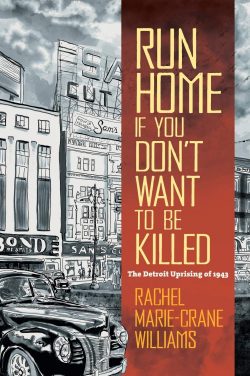

By Rachel Marie-Crane Williams (The University of North Carolina Press in association with the Center for Documentary Studies at Duke University)
ISBN: 978-1-46966-326-5 (clothbound), 978-1-46966-327-2 (TPB), eISBN 978-1-46966-328-9
The greatest weapons in the human arsenal are lies and obfuscation. The number of shocking and unpardonable atrocities inflicted on all kinds of underclasses can never be known because those in the upper ranks of everywhere control the narrative and write the histories. In recent times, however, dedicated scholarship has increasingly reappraised what we “know” by ceaselessly challenging how we learned it.
When explored with the full power of sequential graphic journalism, lost or sabotaged stories can come to life with all the force and immediacy of the actual event and even be enhanced by late-gained context and the perspective of time passed: offering a fuller evaluation of what has actually occurred.
Here’s a powerful and unforgettable re-examination that proves it: the other version of a carefully sidelined, pragmatically sequestered moment of shameful racism from World War II. It employs all the tools and techniques of comics storytelling to shine a stark light on manipulated history that still affects American citizens struggling to come to terms with issues of colour and poverty in the modern world.
Researched and created by Rachel Marie-Crane Williams – Associate Professor of Art and Art History, and Gender, Women’s and Sexuality Studies at the University of Iowa – Run Home if You Don’t Want to Be Killed: The Detroit Uprising of 1943 details one of so, so many comfortably forgotten clashes between black and white, rich and poor to have been airbrushed (or is that whited out?) from our collective experience.
It is primarily an academic text delivered in pictorial form but is no less chilling and effective for that.
Rendered mostly in spiky monochrome pen & ink, combining contemporary quotes and photos, found imagery and collage, targeted typography, informative historical context, inspired documentary reportage, incisive analysis, inspired extrapolation, and candid investigation of the many personalities involved, it tells of how aspiration, deep-seated prejudice and long-cherished beliefs warred with common sense and patriotic fervour at a time when America faced foreign fascist aggression whilst its own citizens employed the foe’s principles and strategies to keep suppressed sectors of its own population…
The book opens with ‘A Note on Language’ as Professor Williams details the purpose of the project and her methodology, addressing the highly charged topic of terminology as used outside its original historical setting…
The report begins with a ‘Prologue’ establishing the situation in Detroit as America faced external aggression and internal conflict. In an era of advanced paranoia and pronounced patriotism, Jim Crow laws continued rolling back the rights of black citizens. These tensions were constant and had recently spread to include the internment of Japanese Americans: adding to a pattern of injustice that had historically constricted or excluded African slaves, Chinese immigrants and the original victims – “Native Americans”.
The situation was exacerbated by government demands that the war effort be “integrated”: all American’s working together for Democracy’s survival. However, as ‘No Forgotten Men. No Forgotten Races’ reveals, long-held antipathies of powerful men on all sides and in every camp prevented progress. At that time, war industries were desperate for workers in their factories, whilst unemployment and artificially-low wages for blacks was at an all-time high…
President Franklin Delano Roosevelt’s response is seen in ‘The Four Freedoms – Executive Order 8802’ with America’s most privileged still wilfully excluding black workers from employment, and sparking a proposed Negro March (for jobs) on Washington. The Commander-in-Chief’s landmark response was an Executive Order prohibiting racial and ethnic discrimination in defence industries. Tragically. even he couldn’t desegregate the military: that was only accomplished in 1948 by his successor…
‘Meanwhile, Back in Detroit’ shows how ineffective passing laws is in changing minds. When black workers rushed out of the South and towards promised jobs, tensions escalated as they competed with impoverished whites for not just work and wages but also housing, transportation and recreational spaces. The industry-heavy city became a powder keg of pent-up intolerance and animosity. One proposed quick fix was a Washington-directed project to build homes for black families, but its completion led to white protesters seeking to prevent the occupants moving in.
‘The Sojourner Truth Housing Conflict’ ostensibly resulted from the white middle class residents of Conant Gardens reacting to the project being arbitrarily situated opposite their own dream homes…
As always, tensions were fuelled and stoked by lies and warnings of robbery, rape, fighting, miscegenation, property value reduction and social collapse: all useful racist slanders which never failed to enflame tensions on all sides. Most importantly, it was true that many leaders of all parties concerned found ways to personally profit from the chaos: businessmen, clerics, agitators, politicians and pundits used the situation to further their own causes…
As civic decision-makers dithered, older solutions also resurfaced and wooden crosses started burning in Detroit as they had in the South for decades. When the first families tried to move into their homes on February 28th 1942 an inevitable riot started, and black people were singled out by police, who used extreme violence and even mounted horseback charges to quell the chaos. In the end 220 people were arrested: 3 were white and never convicted of any crime…
Hostile white crowds picketed the Project until March 10th, when police finally dispersed the organised resisters, and black families began moving in with a minimum of conflict on April 15th. For the rest of the month, 24 companies of State Troopers, 1,400 City Police and 1,720 members of the Michigan Home Guard patrolled the area to keep the peace…
An overview of ‘Labor, Race, War’ details an ongoing undeclared war as federal government struggled against regional intolerance and intransigence to shift America’s working practices. The motivated, mobile black labour force was well-accustomed to lower wages and organised resistance from both rival workers and employers – as demonstrated here with a brief history of white supremacist Henry Ford’s record in the automotive industry, his brutal riot squads and many attempts to stop black workers and women joining the unions he so despised and feared.
A rundown of negro work opportunities from the end of WWI also covers Ford’s part in 1937’s Battle of the Overpass at River Rouge where his enforcers assaulted and terrorised women and workers leafletting the public in hopes of building support for higher wages…
Between ‘1941-1943’ the many organisations that formed to counter the bias against ethnic and female workers finally began to make headway, but constant clashes between white and black populations of Detroit in the wake of numerous new “Fair Employment” measures only intensified. Mass demonstrations eventually forced Ford to hire four black women at the River Rouge plant, but even this minor triumph came at an unanticipated cost…
Further protests and interventions by the NAACP – and other burgeoning pro-rights groups – were countered by white supremacists, adding to the mounting tension and ensuring that – in June 1943 – the pot boiled over…
‘Íle aux Conchons, Hog Island, Belle Isle’ reveals how leisure not toil was the final spark. The Belle Isle Bridge (renamed MacArthur Bridge) connected urban industrial Detroit with an island that was the conurbation’s largest park. On Sunday 23rd over 100,000 working people of all denominations sought to escape punishingly high temperatures, via a quiet day out, with simmering racial tensions studiously put on hold. However, as the sun set something happened and another race riot erupted
Casualties quickly mounted, the police moved in and again almost exclusively attacked and arrested black men. In an era before telecommunications, the situation was clouded in confusion, misinformation and even secrecy. Scared families on all sides were ignored or deliberately deceived by the authorities who believed daylight would bring calm. Instead, morning only brought escalation and ‘Trouble in Paradise’ as the clash evolved into a mobile clash extending deep into the black parts of town.
…And as violence and disorder grew, scurrilous lies on both sides ramped up the fear, outrage and furious responses. Before long white districts were also on the firing line as seen in ‘Rumor, Riots, and Rebellion’…
‘Topsy/Eva’ then deconstructs the event via an anthropological construct derived from the novel Uncle Tom’s Cabin, demonstrating how trigger stories repeatedly used to fuel racial clashes are the same, but flipped to fit each listener’s ethnicity. It’s backed up here by a sampling of typical tales told to potential victims of justifiable outrage, before ‘Up and Down the Street’ resumes as the Island clash assumed mythic intensity, drawing fresh and aggrieved white and black combatants from further afield to defend “their kind” from a ruthless enemy. Fires were lit, rioters became looters and the battle began its second day…
Adapting first-hand accounts, the story builds into an appalling account of institutionalised racism and deprivation that continued for three days, with unprovoked and unsanctioned police reprisals against black citizens continuing for weeks after. Then a sustained police cover up began. The actual riot was not ended by cops, but only after the criminally ineffectual Mayor Jeffries and t State Governor Harry Kelly capitulated to citizens’ demands for federal troops. By the time they requisitioned forces from the President, it was to stop white mobs hunting black citizens…
The troops remained until after the July 4th celebrations, and the uprising’s official death toll was 9 white people and 25 black. City police had killed 17 of the latter. Almost exclusively, the 2,000 arrested were black…
The artful removal of the story from history and shifting of the narrative began immediately and is covered in ‘White Lies’, revealing how opportunistic politicians built their careers on managing how the uprising was remembered, whilst ‘Aftermath’ focuses on contemporary attitudes of the public, indicating how meaningful change had once again been delayed by the hard lessons of fear and intimidation…
The Detroit race riot was one of five confronting the USA in the summer of 1943, and the topic is granted intriguing perspective in ‘Eden’ as survivors of the event recall its worst moments and assess its impact from the safe distance of 1968: a time when the nation again reeled from panic in the streets based on skin colour and good men of all colours were being murdered for seeking change…
Staggeringly forthright and frequently truly disturbing, this tract is chilling, contentious and often overwhelming as it picks at social scabs many believed long healed or non-existent. It is engaging, astoundingly informative and should be compulsory reading for anyone in a multi-cultural society. However, it’s not all doom, gloom and injustice and offers as a ‘Coda’ an adaptation of the Philip Levine poem Belle Isle, 1949 plus an ‘Author’s Note’ detailing her debt to comics journalist Joe Sacco and the road to this book. It also includes even more context on the plight of the poor and disenfranchised in the last century and just how little things have change in today’s world of Black Lives Matter.,,
Completing the experience, a ‘Glossary of People, Organizations, and Laws’ lists in forensic detail the many players and groups (54 in all) that helped shape this occluded debacle, and is supplemented by copious, cogent and compelling chapter ‘Notes’ and a splendidly broad ‘Bibliography’.
There are books you should read, books you Must Read and books like this that one can’t afford not to read. Who you are is determined by which category you fall under…
© 2021 The University of North Carolina Press. All rights reserved. “Belle Isle, 1949” © 1976 by Philip Levine, from THEY FEED THEY LION AND THE NAMES OF THE LOST: POEMS by Philip Levine
